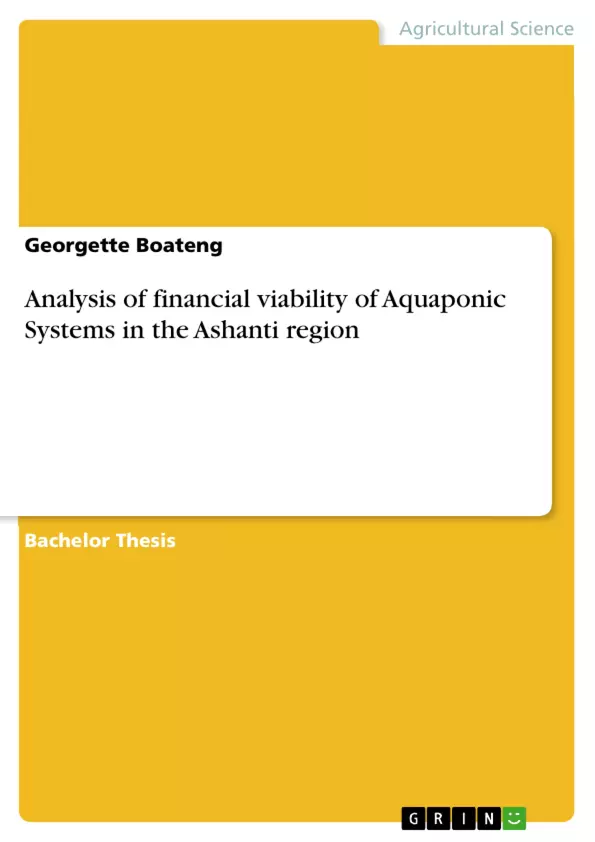Increasing demand on water resources, reduced land water availability, and concerns over food security have spurred the evolution of many innovative and complex food production. Aquaponics is known to be a productive, innovative, and sustainable fish and vegetable production system that is revolutionizing agriculture in the face of drought, soil fertility losses, and climate change. It is an advanced aquaculture-agriculture system, expected to improve food security in developing countries. However, as an emerging technology, there is very limited information on the system in Ghana. Questions about the financial viability, ecological and socio-economic sustainability of Aquaponics are answered in this comprehensive review. This study considers Aquaponics projects in Ashanti Region, looks at the technology, the type of fish and plant yields, and juxtaposes the technology within best-use practices to make recommendations that will inform evidence-based policymaking and highlights the system’s contribution to improving food security in the Ghana.
This study assessed the financial viability of the Aquaponics system using data obtained from Aquaponics farmers in the Ashanti Region. The initial investment, revenues, benefits cost ratio (BCR), net present value (NPV) using 5 years, internal rate of return (IRR), payback period and accounting rate of return (ARR) were modelled to determine the financial viability of the Aquaponics system. The result indicated that Aquaponics system operation is financially viable. Two fish species (catfish and tilapia) were considered for this study due to consumers’ preferences. The most pressing constraint in the study area is high feeding cost followed by power fluctuation and high mortality rate as the least constraint. This study serves as a model for promoting a viable and sustainable unconventional food production system to attain food security and local economic development in Ashanti Region.
Inhaltsverzeichnis (Table of Contents)
- CHAPTER ONE
- 1.0 INTRODUCTION
- 1.2 Problem statement
- 1.3 Research questions
- 1.4 Research objectives
- 1.4.1 Specific objectives
- 1.5 Justification of the study
- CHAPTER TWO
- 2.0 LITERATURE REVIEW
- 2.1 The global state of Aquaculture
- 2.2 The current contribution of Aquaculture to the economy of Ghana
- 2.3 Fish consumption in Ghana
- 2.4 The Actors along the fish supply chains
- 2.4.1 The Fish Supply chain
- 2.5 The Fish market and industry in Ghana
- 2.6 Aquaponics
- 2.6.1 History
- 2.6.2 Design: The basics
- 2.6.3 Location
- 2.6.4 Ideal growing conditions
- 2.6.5 Sunlight
Zielsetzung und Themenschwerpunkte (Objectives and Key Themes)
This study aims to analyze the financial viability of Aquaponics systems in Ashanti Region, Ghana, by examining the technological aspects, fish and plant yields, and comparing the system to best-use practices. The study seeks to provide recommendations that can inform evidence-based policymaking and highlight the system's potential contribution to food security in Ghana.
- Financial viability of Aquaponics systems in Ashanti Region
- Technological aspects of Aquaponics systems
- Fish and plant yields in Aquaponics systems
- Comparison of Aquaponics systems to best-use practices
- Contribution of Aquaponics systems to food security in Ghana
Zusammenfassung der Kapitel (Chapter Summaries)
Chapter One: Introduction introduces the study's context and purpose, highlighting the growing demand for water resources, reduced land water availability, and concerns over food security. It also outlines the problem statement, research questions, and objectives, emphasizing the need to investigate the financial viability, ecological and socio-economic sustainability of Aquaponics in Ghana.
Chapter Two: Literature Review provides an overview of the global state of Aquaculture, its contribution to the economy of Ghana, and fish consumption patterns in the country. It delves into the actors involved in the fish supply chain, the fish market and industry in Ghana, and offers a comprehensive introduction to Aquaponics, including its history, design, location considerations, ideal growing conditions, and sunlight requirements.
Schlüsselwörter (Keywords)
The key terms and concepts explored in this study include Aquaponics, financial viability, food security, sustainable agriculture, fish production, vegetable production, Ashanti Region, Ghana, aquaculture, and best-use practices. The research focuses on examining the potential of Aquaponics systems to contribute to economic development and food security in the Ashanti Region, with a particular emphasis on the economic feasibility of this emerging technology.
- Citation du texte
- Georgette Boateng (Auteur), 2021, Analysis of financial viability of Aquaponic Systems in the Ashanti region, Munich, GRIN Verlag, https://www.grin.com/document/1393239



